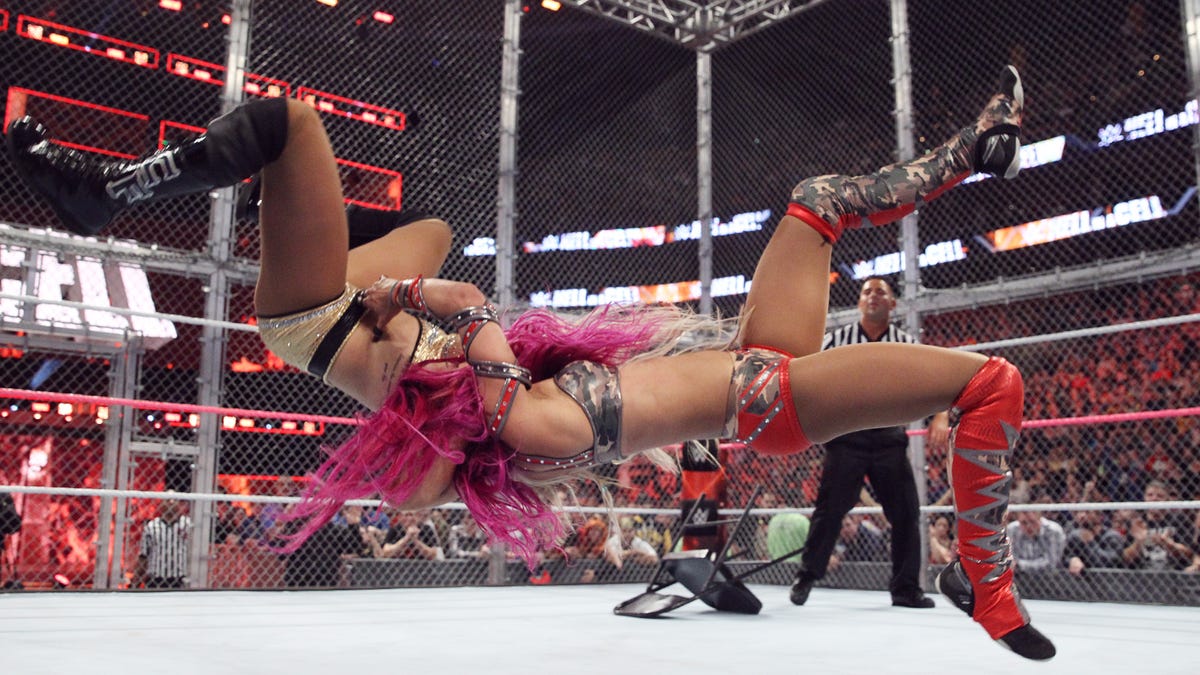Two women just changed pro wrestling forever
Commentary: Sasha Banks and Charlotte were the main event of a WWE pay-per-view -- something no one thought could happen just a few years ago.

Last night, pro wrestling history was made. For the first time, two women, Sasha Banks and Charlotte, main evented a WWE pay-per-view.
"So what?" the non-wrestling fans among us may be thinking. If everything is predetermined, why does it matter that women were the main event?
The headlining match in a pay-per-view (PPV) is the one the WWE thinks will typically sell the most tickets, PPVs and WWE Network subscriptions (WWE's streaming service, the fifth most subscribed to in the US). After Sunday's Hell in a Cell event, we now enter an era where women can main event a PPV.
Nearly 40 percent of WWE's audience is female, so that's a big deal. Especially if you consider the shape of women's wrestling just a few years ago.
Bathroom break
Until recently, women wrestlers were given the "death spot". Their matches would usually come after a marquee men's match and before the main event, giving the audience a chance to recharge their batteries, get a drink or have a bathroom break.
And worse, they were routinely objectified. Women were hired based on their looks and not their wrestling ability, with talent executives reportedly scouring model agencies, not independent wrestling promotions, for talent. When they made the big time, the women were branded as "Divas" while the men were "Superstars".
Vince McMahon, WWE CEO and the man behind all big company decisions, tried in the '90s to promote women as serious performers. He pushed stars like Alundra Blayze as legitimate athletes, but according to wrestling journalist Dave Meltzer, it didn't work. "It was the public not accepting the push," Meltzer wrote.
Sable.
Conversely, in the late '90s, McMahon found great success with "Divas" like Sunny and Sable. They were managers -- characters who didn't wrestle, but were the right-hand men or women of characters who did -- and, thanks to their model looks and charisma, became huge stars.
"Sunny and Sable [were more popular] than Blayze at the time," Meltzer told CNET. "Sunny and Sable were new... it was an era with a very young audience and hot women wearing very little.
Sable in particular was a huge ratings draw," he added.
That would be the catalyst for the Diva era of women's wrestling, which would last nearly two decades. Women were put in "Bra and Panties" or mud wrestling matches. Their regular matches were short, sometimes less than a minute.
This era did produce some stars, like Trish Stratus and Lita, but even they were largely presented as models first and athletes second.
Around 2009, however, the WWE changed drastically. It moved away from the sex and violence of the late '90s and adopted a PG (parental guidance) stance on most of its content. No swearing, no blood and no overt sexuality.
This would have been a good time to build a Divas division around athletics and competition. Instead, women continued to have a token impact.
The times, they are a changin'
Thankfully, the winds of change started blowing in 2014.
In May of that year, Charlotte wrestled Nataya Neidhart in a match that shocked many. Not only was it good, rare since women were restricted with the time to have a good match, it was the best match of that night's show.
"Many would say Natalya and Charlotte had one of the best women's matches in WWE history," Meltzer wrote at the time. "It was a statement."
It took place in NXT, a WWE-run developmental brand that is to the company what collegiate football is to the NFL. And it didn't stop there. The NXT Women's Championship match was consistently pushed as a top attraction, and the women themselves consistently delivered.
In February of 2015, WWE fans made it clear that they wanted the NXT treatment on the main roster. #GiveDivasAChance trended on Twitter as fans saw the blowout matches happening on the developmental roster and wondered why the women on the A-team weren't given the same chance.
Four months later in June 2014, the WWE officially began the Divas Revolution. Charlotte, Sasha Banks and Becky Lynch, three of the best female wrestlers from NXT, were called up to the main roster. The Revolution got off to a rocky start, with matches still too short and character development not improving much, but we eventually saw change.
Charlotte, Banks and Lynch at WrestleMania 32.
Charlotte, Banks and Lynch would end up wrestling each other at WrestleMania 32 this past April. The match lasted 16 minutes, nearly 3 times as long as the 6 minutes the "Divas" got at WrestleMania 31. Perhaps most importantly, they were competing to become the WWE Women's Champion. The company had finally done away with the passe "Divas" term.
It's true that a match scheduled last doesn't necessarily make it the main event. But Banks vs. Charlotte at Sunday's Hell in a Cell was presented as a big deal. The women did everything a casual wrestling fan would expect in a men's WWE main event. They were in a cage (another first), they whacked each other with chairs and crashed through tables.
And both the crowd and the internet were into it (at least until Charlotte, the villain of the two, scored a surprising win).
And just two years ago, the whole idea would have been nothing more than a pipe dream.

